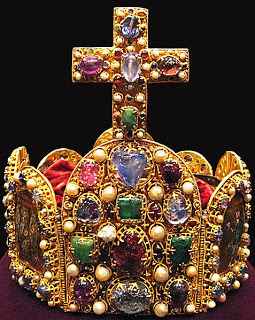Medieval History
 The octagonal crown fashioned from pure gold is studded with 144 precious stones and just as many pearls yet it is a priceless artifact for other reasons
The octagonal crown fashioned from pure gold is studded with 144 precious stones and just as many pearls yet it is a priceless artifact for other reasons
.
The crown almost certainly once graced the head of the first German emperor Otto I more than 1,000 years ago. For hundreds of years it has been one of the most potent symbols of the Holy Roman Empire, the German kingdom which stretched across most of Central Europe.
Today it rests together with the other Austrian crown jewels behind reinforced glass in the Imperial Treasury or 'Schatzkammer' at the Hofburg palace in the Austrian capital Vienna.
'Around 280,000 visitors come here every year,' said Anja Priewe who works for the marketing department of the city's tourist authority. Tourists flock to see the imperial regalia but few of them take the time to look closely at particular objects.
Click here to read this article from Monsters and Critics
- French City Wants British Crown Jewels For Centuries-old ?state Crime?
A French city that produced generations of English kings is demanding the British Crown jewels as compensation for a 15-century execution that ended the Plantagenet line. In a petition that the mayor of Angers, in the Loire Valley, intends to send to...
- Goslar's Perfectly Preserved Medieval Town A Sight To Behold
The historic German Hanse city of Goslar accumulated great wealth in medieval times thanks to the silver mines in neighbouring Rammelsberg while it was also the location chosen by Emperor Heinrich II for court meetings and synods. The mines of Rammelsberg...
- I Don't Hate You, Really
I feel like I should clarify something because, in this post and this one, I'm pretty sure that I'm sounding like I hate the Middle Ages or (perhaps better) that I hate the people who lived in the Middle Ages. That's not true at all. Granted,...
- 'monokeros,' Or Unicorns In Imagery And Myth
Celestial Globe, detail: Unicorn, Joseph-Jérôme Lalande, 1775. Private Collection, Vienna, Austria Italian dish, possibly made in Pesaro in 1486-87. Maiolica (tin-enameled earthenware), Metropolitan Museum of Art. The maiden has lured the unicorn...
- Pope Sylvester And The Regalia Of St. Stephen (happy New Year!)
December 31st is the feast day of St. Sylvester, that is Pope Sylvester I (314-335), well known as the recipient of the Donatio Constantini, in which Emperor Constantine transferred power over Rome to the pope. The document is actually an 8th century...
Medieval History
Austria's crown jewels offer a unique insight into medieval Europe

.
The crown almost certainly once graced the head of the first German emperor Otto I more than 1,000 years ago. For hundreds of years it has been one of the most potent symbols of the Holy Roman Empire, the German kingdom which stretched across most of Central Europe.
Today it rests together with the other Austrian crown jewels behind reinforced glass in the Imperial Treasury or 'Schatzkammer' at the Hofburg palace in the Austrian capital Vienna.
'Around 280,000 visitors come here every year,' said Anja Priewe who works for the marketing department of the city's tourist authority. Tourists flock to see the imperial regalia but few of them take the time to look closely at particular objects.
Click here to read this article from Monsters and Critics
- French City Wants British Crown Jewels For Centuries-old ?state Crime?
A French city that produced generations of English kings is demanding the British Crown jewels as compensation for a 15-century execution that ended the Plantagenet line. In a petition that the mayor of Angers, in the Loire Valley, intends to send to...
- Goslar's Perfectly Preserved Medieval Town A Sight To Behold
The historic German Hanse city of Goslar accumulated great wealth in medieval times thanks to the silver mines in neighbouring Rammelsberg while it was also the location chosen by Emperor Heinrich II for court meetings and synods. The mines of Rammelsberg...
- I Don't Hate You, Really
I feel like I should clarify something because, in this post and this one, I'm pretty sure that I'm sounding like I hate the Middle Ages or (perhaps better) that I hate the people who lived in the Middle Ages. That's not true at all. Granted,...
- 'monokeros,' Or Unicorns In Imagery And Myth
Celestial Globe, detail: Unicorn, Joseph-Jérôme Lalande, 1775. Private Collection, Vienna, Austria Italian dish, possibly made in Pesaro in 1486-87. Maiolica (tin-enameled earthenware), Metropolitan Museum of Art. The maiden has lured the unicorn...
- Pope Sylvester And The Regalia Of St. Stephen (happy New Year!)
December 31st is the feast day of St. Sylvester, that is Pope Sylvester I (314-335), well known as the recipient of the Donatio Constantini, in which Emperor Constantine transferred power over Rome to the pope. The document is actually an 8th century...
